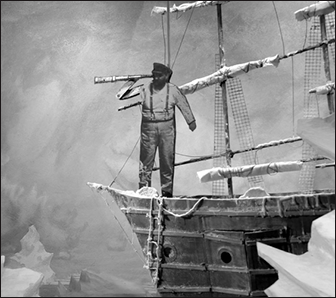By Adrienne Urbanski
Frankenstein (Mortal Toys)
Written by Erik Ehn
Directed and Designed by Susan Simpson and Janie Geiser
Through January 19
HERE Arts Center
145 Sixth Avenue at Dominick Street
(212-352-3101; here.org)
Puppetry too often is written off as the stuff of Saturday morning cartoons and children matinees. However, Automata and HERE Art Center’s production of “Frankenstein (Mortal Toys)” proves that puppetry can convey terror and suspense just as intensely as actors on the stage and screen.
The production uses a miniature proscenium frame to stage the work, and intricate puppets based on 18th century American portrait paintings. Both the script as well as the visual style of the production remains loyal to the Shelley text, beginning and ending the work on an eerie Arctic sea where Victor tells the tale of his monster to a ship’s captain. The beautifully painted puppets, combined with elaborate and inventive scenery, serve to embody the fear and isolation present throughout the original text.
Movement is constant throughout the production; unlike typical puppetry sets, the scenes move along with the puppets. Rolling Hills, crashing waves, darting sailboats and soaring birds all add a lifelike quality to the set. Accompanying the production is a live score by Severin Behnen wrought with frigid sadness.
The work was directed and designed by Susan Simpson and Janie Geiser as part of HERE’s Dream Music Puppetry program, which includes seven new multidisciplinary works that incorporate puppetry, dance, and mixed media. Simpson, a co-director of Automata, has been resurrecting puppetry as an evolved art form for years, putting on multi-media marionette plays, and using both puppets and stop motion animation in her films. She shows her abilities for these mediums in “Frankenstein” by interjecting the production with interludes of both film and stop motion animation.
Sitting alongside the frame are actors Chris Payne and Dana L. Wilson who provide voices for all of the characters, quickly moving from the croak of Frankenstein’s monster to the bubbling laughter of children, all in the same breath. The two also serve to transition the different aspects of the work, sometimes pulling open boxes alongside the main scene to reveal darting shadow puppetry, or the blank frightening stare of the monster himself.
Time seems to shift constantly throughout the work — characters die only to reappear later on in scenes — and as an audience we are sometimes lost as to where we are within the play’s storyline. The small, intricate puppets also present a problem as the more minor characters blur into one another, until the only discernable voices throughout the piece are that of Frankenstein and his monster. And yet, the intense mood of this production is impressive for a puppet show, and leaves the audience with a lingering sensation of dread.

























